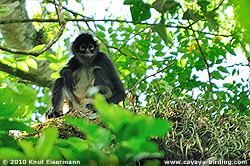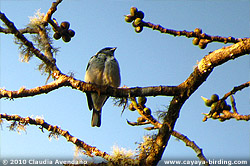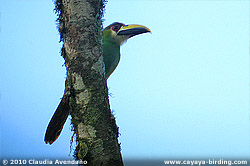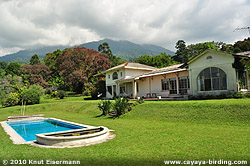A Spider Monkey in the forest of Los Andes Reserve in February 2010
Our 3-day visit in the last days of February was dedicated especially to observe Resplendent Quetzals. Together with Don Chus, local guide in the Los Andes Reserve, and a friend from Germany, we drove early in the morning from the Los Andes lodge through the coffee and tea plantations to the edge of the forest at about 1400 m. We entered the forest walking uphill along the trail, a Mottled Owl was calling in the darkness, and later a Barred Forest-Falcon, which is a rare species on the Guatemalan Pacific slope. We heard the whistles and wing rattles of displaying Highland Guans throughout the forest. At daybreak, several male Resplendent Quetzals were singing series of slowly rising double-notes, culminating occasionally in a display flights over the canopy. Suddenly a male perched right over our heads in the canopy, and we could see its pumping thorax while singing. Song activity of quetzals was quite short and we assume that the birds were attending their nests already.
In an immense crown of a strangler fig tree we saw several Azure-rumped Tanagers, Blue-crowned Chlorophonias, Common Bush-Tanagers, Flame-colored Tanagers, Emerald Toucanets, and a Magnificent Hummingbird. An immature male Black-crested Coquette feeding on small flowers in the forest mid-story was a nice surprise.
A much bigger surprise, however, was a mammal. The motion of some large branches high up in the canopy caught Don Chus' attention in the morning of 27 Feb. He was focused on the spot, but the animal was hidden in dense foliage. Then it moved on and Don Chus recognized it as a monkey, and very excited he called us to come close to see it. Don Chus knows the forest at Atitlán volcano since decades, but he had never seen a monkey there before. This is because of a sad reason: Spider Monkeys require undisturbed forest, hunting and habitat destruction have wiped out this species from the Guatemalan Pacific slope. Also, the single female which we saw does not raise much hope; the brownish fur on the back, white cheeks and very bright inside limbs identify the Spider Monkey as Ateles geoffroyi yucatenesis, a subspecies native to the Yucatan peninsula and common for instance in the Tikal National Park. The subspecies native to the Guatemalan highlands is much darker. Therefore the single female in the forest at Atitlán volcano must have escaped from somewhere or been released.
Back in the lodge, Don Chus reported excitedly about our Spider Monkey observation to the staff, and we showed some proof photographs to everybody. After finishing our notes on our quetzal observations we enjoyed a delicious dinner and a tranquil night in the Los Andes lodge.
Knut Eisermann & Claudia Avendaño



